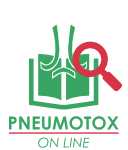The innumerable possible adverse effects must be checked in every patient on amiodarone (PMID 28643175). Preventative guidelines for monitoring must be adhered to (PMID 28643175). The most typical pattern of involvement is referred to as 'Amiodarone Pulmonary Toxicity' (APT) (PMID: 15062598, 23835168). Reviews at 15062598, 18460037, 22529166, 23835168. Ruling out left heart failure and its impact of PFT is important (PMID 23326457, 2337106). Imaging at PMID 11332563. Wide spectrum of respiratory manifestations can be seen. Occasionally severe or fatal. Adverse pulmonary effects can develop acutely over a few days (PMID 22315750) or up to a decade into treatment. Peak onset is 6-12 months and is somewhat dose-related. Patchy opacities in the context of malaise, cough, moderate fever and pleuritic chest pain is suggestive. Can produce an ARDS picture, especially in the postoperative setting. High attenuation numbers (>70 HU) of liver and thyroid on unenhanced CT are suggestive. Drug discontinuance, though necessary, often does not suffice and steroids are indicated. Management of underlying arrhythmia essential. Prolonged corticosteroid therapy often indicated. Most patients exhibit late cicatricial opacities. In a few, pulmonary fibrosis follows. Pulmonary toxicity can develop after low-dose amiodarone (PMID 9283542). Guidelines for monitoring available at PMID 10871966, 14749697, 19399307, 21507859, 21870892, 23640245. Studies indicate that these are suboptimally implemented. Relative risk of AE for each organ system vs. placebo available at PIMD 31871983
3
5
2
2
1
1
3
2
3
3
1
1
2
3
2
5
5
2
1
3
2
2
1
1
2
1
2
3
1
1
-
1
1
1
1
1
2
1
1
3
1
1
2
1
1
1
1
1
1
1
1
1
1
2
1
2
1
1
1
1
2
1
3
1
1
4
4
1
1
1
3
1
1
1
1
1
1
1
1
1
1
2
1
2
1
1
1
1
1
3
1
3

